#14th century reenactment
Text


Medieval Posture ™
#medieval reenactment#medieval#14th century#14th century reenactment#reenactment#medievalcore#costuming#photography#medieval clothing#medieval manuscript#sca#innilgard#i’ll be on my merry way now
306 notes
·
View notes
Text


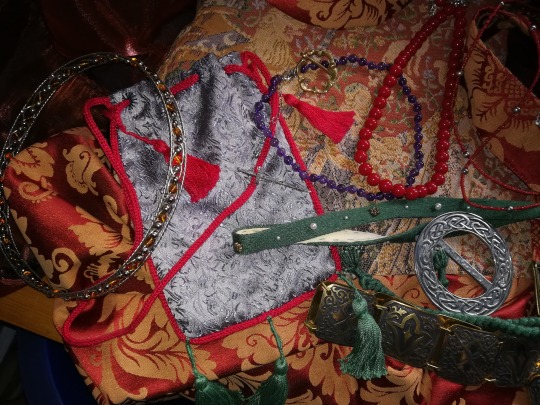
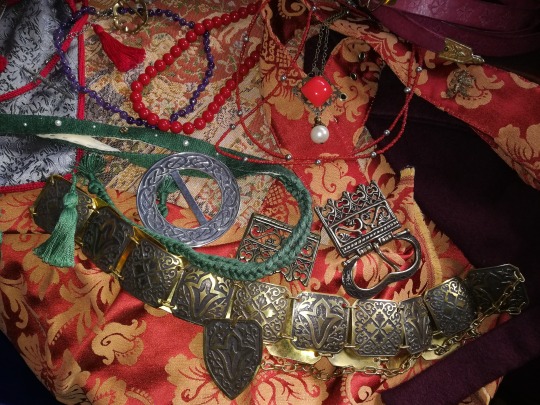

Medieval bling 😁✨⚜️! Medieval aesthetics™ are chef's kiss 👌❤️
. ⚜️Fillet: @/ariadnekordella_tablet_weaving
. ⚜️Purse: @/pylaccessories
. ⚜️Dark red embossed belt: @/handmaderevolution_to
. ⚜️Metal belt: @/armstreetcom
. ⚜️Circlet: @/precious.plunder.official
. ⚜️Burgundian buckle: @/pera_peris
. ⚜️Small oval fibula: @/northern.traders
(IG handles just for reference, none of it is sponsored xD)
14th Century reenactment
DeviantArt
FB cosplay page
IG cosplay page
#middle ages#14th century#15th century#medieval#medieval reenactment#reenactment#historical reenactment#medieval aesthetics#medieval fashion#My reenactment#medieval costuming#historical costuming#14th century fashion#14th century reenactment#15th century fashion#15th century reenactment#burgundian fashion#hennin#fillet#medieval belt#medieval purse#circlet#medieval jewelry#medieval headwear#medieval costume#medieval headband#liripipe hood#steeple hennin#medieval necklace#medieval brooch
9 notes
·
View notes
Text

Heck I finished the embroidery.
Now gotta wash it and then make a bag out of it
#long arm cross stitch#medieval reenactment#fourteenth century mafia#14th century mafia#malyss does a&s
53 notes
·
View notes
Text
Dressing the Despencers, pt 2
Part 1
And so it continues. With the supportive underkirtle complete and worn at an event (under a different kirtle of mine) to make it relax the rest of the way, I got the measurements for our Edward and Thomas Despencer and started marking and cutting materials. While I originally believed I would have more than enough of the bronze patterned fabric, I was proven quite wrong and resorted to piecing together several gores and small extensions in the front of the body for Elizabeth and Edward Despencer. The planned change in the last post (bronze body with blue sleeves for Edward and green sleeves for Thomas) was shifted again, back to my ideal of particolor for the married couple and coordinating for the brother in law. I also realized halfway through marking that I was 2 gores and a sleeve shy of enough of the blue, which led to much wailing and gnashing of teeth. I found a similar-enough-at-a-distance blue satin at OKC fabric market, pictured on the right. Flash makes the differences obvious, but there will be very few flash photos taken of this. It'll be fine. I'll be fine. I'm so normal about this.


Because all 3 outfits have similarly sized pieces in similar fabrics, I've taken to organizing them in 3 individual cubes to keep everything straight. It has been a real game changer, and I would recommend it to everybody.

Having cut out and serged everybody's blue and bronze fabric, I dug through my stash of scrap linen to make the lining. I worry the bronze especially won't hang exactly right without lining. Additionally, I'm making the cotes for Edward and Thomas Despencer for a pair of high school seniors who, while I hope they wear an undertunic at the NMF, I plan and prepare for them not to do so. For reasons I cannot fathom, I chose not to serge the lining pieces for Edward Despencer's cote, seen below. Yay, hand finishing.
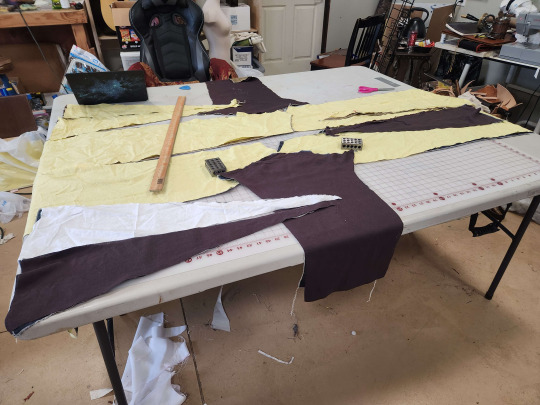
I usually bag line lined garments, but I also usually make garments in 2 layers of linen. I didn't want a bag lined garment to sag weirdly, so I sandwiched each seam, treating the lining and outer together as one piece of fabric each.
The picture below has two notable features: first, the blue of the body and the blue of the gore are the two different blues. This was proof of concept enough for me to accept the differences aren't terribly noticeable. Second, I did not bother pattern matching the various pieces of of any of the garments. Working from two extremely limited quantities of fabric, I found myself in the position I'd imagine many tailors in period would know well. Laying out pattern pieces over and over, I found the only way to effectively and efficiently use as much of my material as possible is to squeeze things in where I can (while still respecting the grain). I would like to find documentation on this speculation, but I would not be surprised if it is more period to not pattern match fabrics for anything less than a royal coronation garment. And the Despencers, while being played as nouveau riche landed nobility and close friends of the heir apparent, do not have pattern matching and wasting fabric money.

With Edward Despencer's cote largely assembled and waiting until I can do one more test fitting before I add button holes, I started assembling my/Elizabeth Despencer's outer gown. By this time, I decided for the remaining two Despencers to only line the 4 body panels, since that will help the drape enough in my humble opinion.
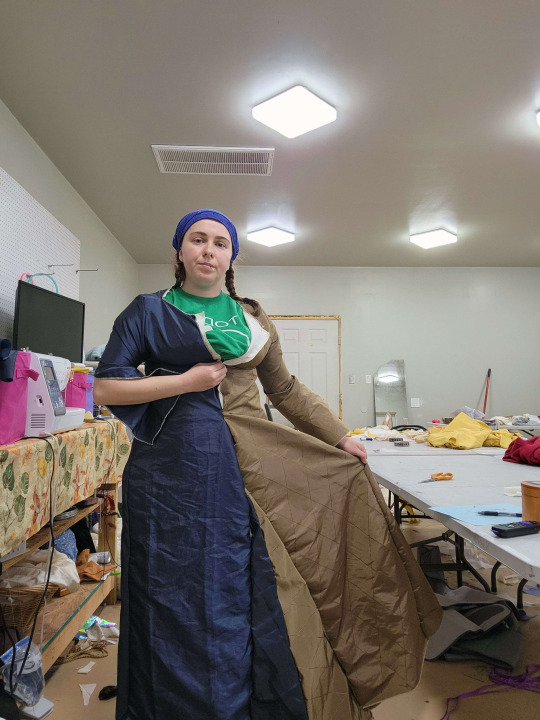


Don't worry, those gores get scooted up to a better height. I found myself working from Morgan Donner's example of a supportive kirtle, where her gores start where the flare of the bodice in the 4 body panels stops and turns into the straight lines to the floor. I still haven't quite figured out why mine looked so bad and noticeable in comparison to hers (seen below), but my best guess is the difference in drape of material, the fact that Mistress Donner is significantly smaller / less beefy in the hips than I, or that I just straight up placed them wrong.

I do love how much space the dress makes me take up though. It makes the transition from street to court feel a lot easier, I'm playing nobility and I take up space.
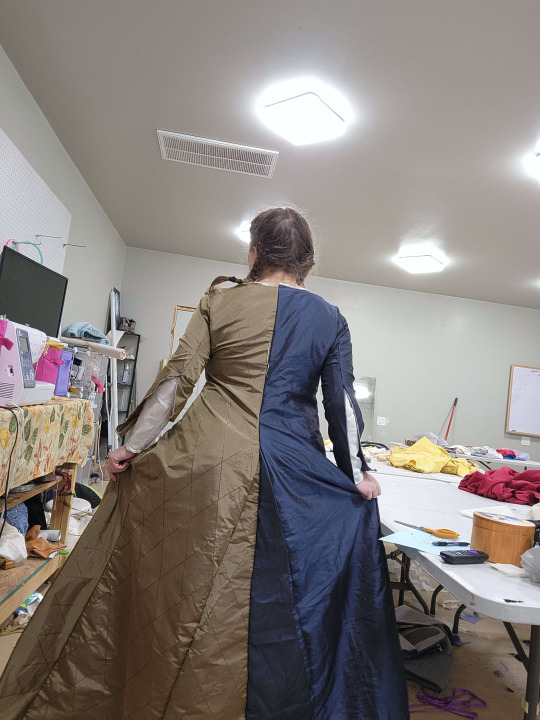
Tragedy struck and I realized I was short about an inch across the bust. Still not sure how I managed that, but it was time for a fix. Piecework is period, and I maybe panicked a little and overdid the width, but I added plackets to both sides of the front closure to give me more working room.

Then came the buttons, which I purchased from Bad Baroness buttons. I. Am. Obsessed. I wanted enough to do my front closure to the waist, both boys all the way to the hem, and sleeves for everybody. So I overdid it and bought 150. On my bodice, I spaced them about a button and a half apart to avoid gapping. Because the fabric doesn't play nice with chalk, I ran loose basting stitches to mark my button holes before I made them. Rather than using my wife's fancy new brother with an automatic buttonhole function, I learned how to use the button hole stitches on my old Janome (finally.) Overall, not a bad experience, and it means I don't need to borrow a machine to do buttonholes.

Then came what has been the most stressful point so far. Mistress Elizabeth Caton and Countess Amelot Lisette joined us for an unrelated sewing weekend extravaganza, and I took advantage of their expertise to help with fitting. Thus, the gores got moved up, and the sides taken in more. I really over did it with those front plackets RIP. But tragedy of tragedies, in moving the gores up, I left the dress 4 inches too short in places. Upon consultation with my trusted countesses and friends, we reverted to the original design with the red band and lions at the bottom. I was hesitant to do this because of the cast's restriction of true crimson to the royal family for readability reasons, and because it's not something I see much of in period depictions. However, the rest of the costuming committee reminded me of my own "10 foot squint rule", where if the costume isn't overwhelmingly crimson at 10 feet and squinting, it's fine. And this contemporary depiction of Mary of Waltham (Princess Mary) has a surcoat that appears to have a contrasting band at the bottom which may match gores going up the sides. The decision was made to cut myself some slack and get this workable ASAP.

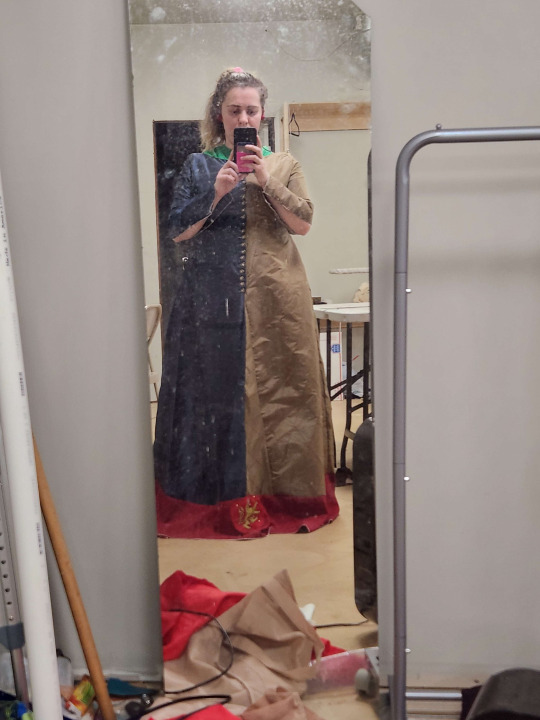

Much appreciation to Halldora for loaning me her machine and helping me embroider these godforsaken Burghersh lions.
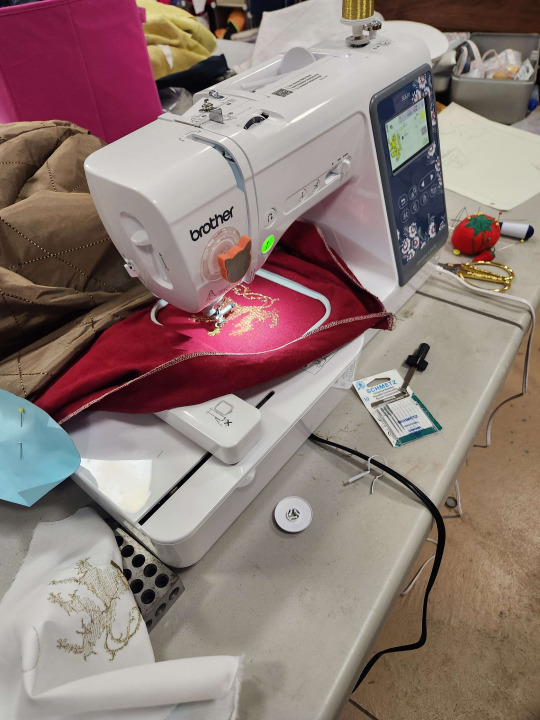
What comes next?
I need to finish the lions on Elizabeth's dress and hem the excess.
I need to add buttons and buttonholes to Elizabeth's sleeves
If the sleeves are too short, I may add contrast red cuffs of the same fabric as the hem, or gold cuffs and embroider them with the Glamorgan chevronelly in the Despencer arms
Buttons down the front of Edward Despencer, and close his sleeves. It's been fitted, and I had to add the button placket of despair to his garb as well.
Seam finishing for Edward :) since I didn't serge the lining for some reason :) I hate myself :) i've at least already started this.
Assemble and line Thomas's cote. I will definitely need a button placket on his too, I girlbossed too close to the sun and made the chests just a wee bit too tight for their comfort. For Thomas's, I'm going to embrace the pieced look and use some dark brown linen for the center closure.
Dye and attach the false sleeves for Thomas, they're going to be a lovely green :)
Hems and necklines for everyone!!
If i have time and spoons, I would LOVE to put some mammen scrollwork embroidery on at least one of the boys' cotes.
I am attending Ansteorra's Laurel's Prize Tournament this coming weekend and hope to have enough done on the Despencers' clothes to present them, so fingers crossed!
#arts & sciences#a&s#sca#society for creative anachronism#historical costuming#wip#norman medieval fair#medieval costuming#historical reenactment#medieval garb#kirtle#cotehardie#cote#14th century
7 notes
·
View notes
Text
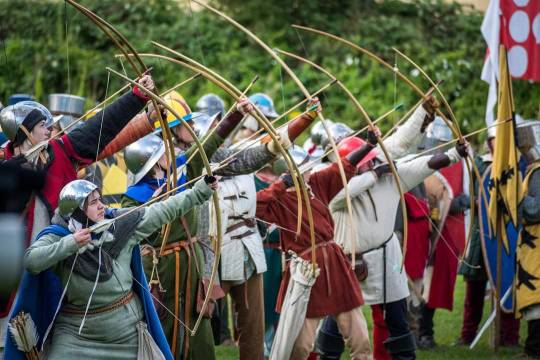



Battle of Evesham, 1265, August 2023
#WHY WAS THERE A MAN IN A WW1 HELMET#WHO LET HIM ON#also the gambis on archers?#WRONG#take that shit back to the 14th century#take your heatstroke too#there were people in my group who were leaving kit behind because it was 100 years out and then you see a guy in plate or winnegas and think#what's the point#this hobby is giving me a special annoyance for Viking reenactors#archery#reenactment#medieval#sewing
14 notes
·
View notes
Note
Do you have any recommendations for books about the everyday lives of medieval people? The last two that I’ve read were just disappointing, leaning far more into sensationalism than anything, and not taking into account the changes in worldview and society between then and now. I love everyday history of how people went about their lives, from how they made breakfast and what they wore, to the games they’d play to pass time and what they thought of their place in the universe. I love your historical posting and was curious if you had any recommendations for non-disappointing books to read! (I read better in English than German, but either would be appreciated!)
Cool to hear you are interested in 'domestic history' as it is often called!
I read these kinds of books mostly in german as I am interested in central european medieval times, as most english books are about britain and france. So I am sorry, most of this stuff is German.
Personally I was very, very happy with 'Wien in Mittelalter' by Peter Csendes & Ferdinand Opll, which is as the title says about Vienna in medieval times (from ~900 until 1529, which is the date set as the end of the medieval times in austria). First half is a timetable for each year, based on documents found in the archives to state what happened. Not only what kings and dukes did, but also e.g. 'Frenz sued his neighbour because his window is built wrong'. Tells you a lot about things people cared about. Second half describes in detail how e.g. the city was divided, how it was governed, how people lived etc. I really, really liked it, but it is mostly about Vienna and its Bürger and thus does not go into detail of the world beyond.
In addition to that, speaking of Vienna, there is the Geschichte Wien Wiki, which is one of the best history wikis in the world! So much details and also images of a lot of maps and stuff, it is great!
Another book I am currently reading (and loving) is also German, called 'Unerhörte Frauen' by Henrike Lähnemann and Eva Schlotheuber, and is about medieval nuns, mostly of the late 15th century in Germany. It discusses diaries of nuns and also explains how they lived, how the cloister was set up, how their education looked like, etc. It is really nice and it is very well researched, putting attention to often ignored women!
When it comes to food I generally read the actual recipe books from the time, as it is the best representation for it. There are also a lot of blogs from reenactors talking about it. For example this blog where some of my friends are involved, focused in 14th century cooking (also german).
I also recommend this blog by an Austrian reenactment group, where they talk about a lot of cool medieval topics. They are very passionate and have a lot of references (also German but have some posts also in english)
Going more specific and maybe boring there is this 7 book set about the finds of excavations in London. I have two of them by now, and it is quite cool to see what people used, how it looked like, what was common, what stuff was made of. But it is very thechnical/academic, so maybe not what you may be looking for. My reenactment friends and I love these books because it helps a lot in recreating stuff authentically.
Otherwise I read not that many books about medieval life, I mostly read research stuff and read medieval literature (I made a long post about it a while back) and talk with my nerdy friends about it
I hope this is useful!
Any of my followers, feel free to add if you know cool books and stuff :)
81 notes
·
View notes
Text
Home is with You
(a short dreamling drabble I wrote because it was raining)
Hob is homesick and meets his stranger in his dreams.
(AO3)
This evening, Hob doesn't know what to do with himself. He is bored, and homesick. There's something about the rain on the roof that makes him think of home. His old home, back in the 14th century. The rain had never sounded like it sounds now - back then, it had been more muffled, falling on straw and wood rather than aluminium and bricks.
As he lies on his couch and listens to the rain he wonders if he should go on vacation. Take a hike, camp out in the woods, or even better, book a stay at one of those old history reenactment sites, where he can sleep in the straw, smell the pigs and listen to the rain fall on the thatched roof.
Yes, that would be nice.
He falls asleep with the unforgettable memory of the distinct smell of pigsty in his nose, and dreams of his mother's smile and the way her hands had been smaller than his, at the end.
All the while the sound of the rain is a constant, soothing sound at the back of his mind. Soon the rain is all he can hear, his mother and home no longer visible. He is standing in a dark field, rain pouring down on him. Thunderclouds are rolling on the horizon and occasional flashes of far off lightning illuminate them.
"Hob," a familiar voice says to his right and he turns toward it.
"Hello, Stranger."
Hob smiles at the black-clad figure striding slowly towards him. His stranger stops only a feet away from him and Hob is fascinated by the fact that the rain is not making him wet. It seems to slide off of his stranger like from a duck's back. Meanwhile Hob can feel the rain running down his face and back, his long hair hanging in soaked strings down on his shoulders. The rain is warm, though. It doesn't bother him. Something else is, though, and he frowns at the stranger.
"I haven't seen you since 1889. Where were you?"
The stranger stiffens and a flash like lightning strikes through his pitch-black eyes before he turns them away from Hob, staring out into the distance. Hob follows his eyes and sees that the receding storm clouds have been hiding something - a castle, with more turrets and towers than Hob has ever seen. It looks like half of it has crumbled, though.
"There is much to repair," his stranger says and Hob looks back at him.
"Can I help?" he asks, hope unfolding in his chest. It feels natural that he should meet his stranger here, on this field, in the rain, although a small part of him is slowly realising that this is weird, this can't be real.
"Am I dreaming?" he asks with realisation, and his stranger looks back at him and nods slowly.
"Yes. Hob...I will visit you soon. Once the necessary repairs to my kingdom have been made," he says solemnly, and Hob nods and smiles.
"Please. I am waiting for you. Always."
Hob wakes up and remembers only a tiny smile on familiar lips.
77 notes
·
View notes
Text
so after my italian renaissance class last year (which had a very big LARP element) i’ve taken the advice of my aunt and mom and decided to try to join the SCA. i’ve done some looking online and i’ve joined a bunch of facebook groups and emailed some folks, and i have my first event in my calendar! and now the next step is to make my garb (which frankly is where half of my interest stems in the first place).
so far i’ve just been doing a ton of research into medieval/early modern clothing, since i don’t have my sewing machine with me here in chicago (but i will be bringing it back with me when i visit home for christmas). so far i’ve started a big google doc of links to blogs and patterns and stores (i want to make most of my garb myself, but i am going to buy shoes because i have zero desire to take up leatherworking just yet), and next i need to plan out my outfit and the colors and whatnot. i’ve been torn between clothing from 14th century england and 15th century italy, but my actual persona is going to be italian so i’m going to start with that and then maybe make some 14th century garb for my friends, who i am also trying to get into reenactment with me.
the thing is, i already have patterns for both a medieval hood and a cotehardie, but it seems like for most of the things i want to make, regardless of era, require that i learn how to draft a pattern so it can be properly form fitting. so there’s a lot of sewing skills I’m going to need to work on!! thankfully i will have my mom around to help me when i go home for Christmas :)
hopefully i can pull something together before 1/6 for my first SCA event, otherwise i’ll have to find something to borrow off of someone, which does mean that i really need to start holiday gifts maxxing right now before i go home and have to start sewing like crazy (because i am insane and insist on handmade gifts every year)
anyway. i’m really excited about this!!! i’m really excited to join the SCA it seems extremely cool and fun and i’m excited to meet other people who are as weirdly invested in the italian renaissance as i am (🤞🏽🤞🏽). and i will definitely be posting garb updates:tm: as they happen
#my stuff#hmmm i need a tag for crafting#also i’m in the midrealm in the barony of ayreton so if any chicago SCAdians are on tumblr HI!!!!#SCA
30 notes
·
View notes
Note
What are your favourite time periods besides Roman empire?
I'm actually a Late Republic kind of guy, idc much about the empire except for Caligula, but! to answer your question:
12th-14th century italy, imperial china (specifically the ming dynasty), colonial-revolutionary philippines, fucking. colonial america (or amrev, as some people refer to it. this one I hate admitting because I'm so fucking disinterested in the romanticized version of it that a lot of people enjoy, but I've been obsessed since I was 7 and when I was living in new england I spent all my free time going to reenactment events and museums)
#the joseon dynasty and medieval history interests me a lot too#old and middle kingdom egypt. what else. 14th-16th century japan??#also 1800s japan but specifically the shinsengumi#ask tag
29 notes
·
View notes
Text
very important factor to consider is that modern!au keradin would be a history guy either ww2 (in a red flag way) or the crusades (even worse). 90% of his disposable income he spends on replicas (it is a very big collection) and he wants to get into reenacting to expand his social circle but on the message boards he posts a lot of negative reviews of his purchases ("pike handle is constructed from marbelled cedar pine when this is a recent human bred GMO lumber and not historically accurate also from archaelogical fragments we know that the diameter of the grip was approximately 3mm thinner than product to accomodate for the extra bulk contemporary gauntlets would provide. advertised as completely handcrafted but the detailing is clearly laser engraved also the so-called 13th century heraldry is clearly drawn from 14th century trends please remedy immediately") and he comes across abit serial killery. so the sellers have all blacklisted him from their meets
8 notes
·
View notes
Text
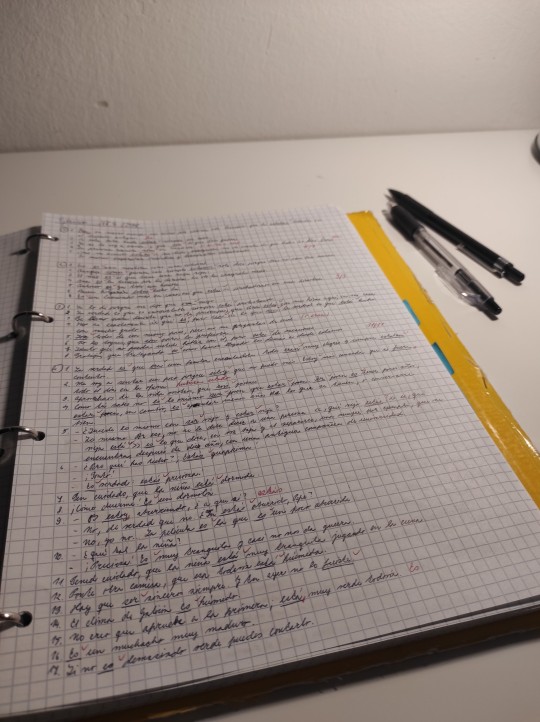

15. 1 2023
Managed to pass two exams so far (The Theory of Applied Linguistics and Spanish literature), got new fabrics for reenactment and took three days off to hand-sow a 14th century linen shift. It's sooo comfy and warm, maybe even a bit too warm, so I might do another one, thinner and better suited for summer.
Failed Spanish grammar (once again, honestly I'm not even surprised), so I'm studying for that and Textile production. Let's hope for the best!
17 notes
·
View notes
Text

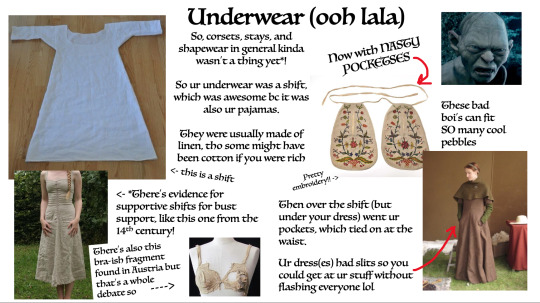
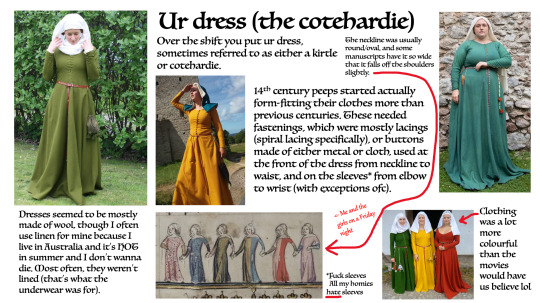
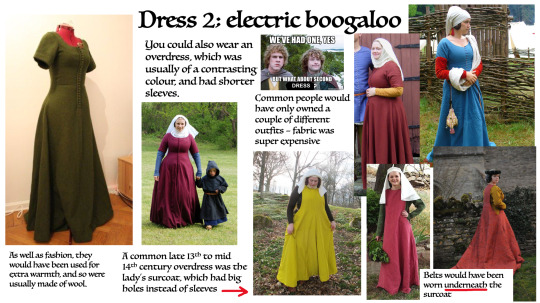



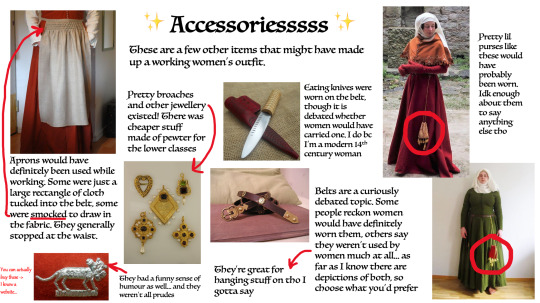
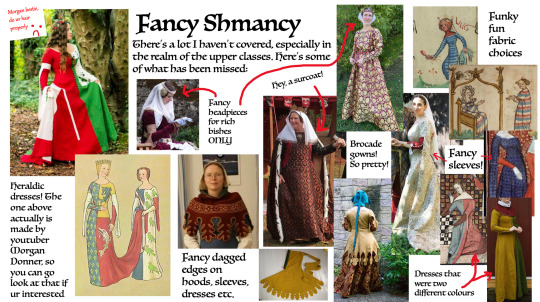
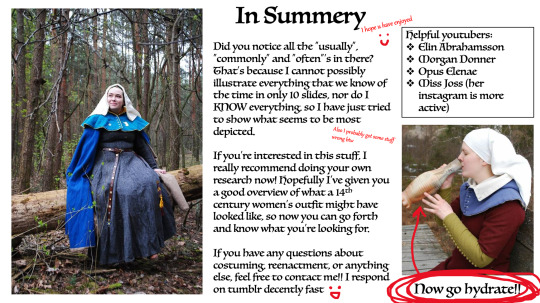
If you’re on mobile, you may have to click on the images for better quality!
Plain text version with image descriptions is under the cut.
Please note that the image descriptions will be reflecting what I am trying to convey with the photo, rather than the total look of the photo itself. For example if I am trying to describe a dress, the hair colour of the person wearing it will be ignored. This is to reduce the total word count of the descriptions, because I have a lot of images to describe. On this note, I have also streamlined the information as much as possible.
[Plain text description:]
First slide: Mariota’s Guide to 14th Century (Medieval) Women’s Clothing
This slideshow is brought to you by @the-merry-otter on tumblr
ALRIGHT LISTEN UP MOTHERS AND FUCKERS. I’m bored, so today we’re going to be talking about medieval clothing. Specifically fourteenth century English clothing because that’s what I’m good at. (Source: trust me bro I’m a reenacter). Also this is all female stuff - sorry masc leaning folks, I’ll get to you someday!
Disclaimer: this is not completely comprehensive or nuanced in the slightest, it’s just a quick overview guide. Do your own research xoxo.
[Image ID: to the left is a picture of a woman in a light blue dress and a pink hood gazing out at a lake. The hood has a skirt that falls over her shoulders, and there is along thin pipe attached to the back of the hood that dangles to her knees. The edges of the hood are decorated with burgundy crochet. The picture is captioned “beautiful, stunning, gorgeous, literal goals.” End ID]
[Image ID: To the right is a picture of a typical renn faire outfit. It has a white poofy underdress, a black corset, and a brown skirt. There is a red cross drawn over the image. It is captioned “very pretty, but definitely not medieval sorry!” End ID]
Second slide: Underwear (ooh la la)
Now with nasty pocketses
[Image ID: a picture of gollum, from lord of the rings, snarling in disgust. There is a line in The Hobbit where he asks Bilbo what he has in his nasty little pocketses, which is what I am referencing. End ID]
So, corsets, stays, and shapewear in general kind of wasn’t a thing yet. So your underwear was a shift, which was awesome because it was also your pajamas. They were usually made of linen, though some might have been made of cotton is you were rich.
[Image ID: A plain white linen garment laid out flat on the floor. It is a dress that hangs to about knee length, with elbow length sleeves. An arrow points to it with text reading “this is a shift”. End ID]
There is evidence for supportive shifts for busy support, like this one from the fourteenth century!
[Image ID: a second shift, worn by a female presenting person. It is laced up the front, and is a lot tighter and more fitted, especially around the bust. It has straps instead of sleeves. End ID]
There’s also this bra like fragment found in Austria, but that is a whole debate so.
[Image ID: A bra-like garment fitted to a mannequin. It seems to be made out of white linen, coloured with time. The left cup is damaged, and overall the garment looks incomplete. End ID]
Then, over the shift, yet under your main dress went your pockets, which tied on at the waist. Your dresses had slits do that you could get at your stuff without flashing everyone lol.
[Image ID: A picture of medieval pockets. They are upside down teardrop shaped, but the point is flat and is part of the waist ties. There are slits in the side up the top to access the inside. They are cream coloured with bright floral embroidery. The caption reads “these bad boys can fit so many cool pebbles.” End ID]
[Image ID: A young female-presenting person wearing medieval clothing. She has her hands in the pocket slits of her dress. They are just below hip height. End ID]
Third slide: your dress, or the cotehardie. (Pronounced coat hardy)
Over the shift you put your dress, sometimes referred to as either a kirtle or cotehardie. 14th century people started actually form-fitting their clothes more than previous centuries. These needed fastenings, which were mostly lacings (spiral lacings specifically), or buttons made of either metal or cloth, used at the front of the dress from neckline to waist, and on the sleeves from elbow to wrist, with exceptions of course.
(Sidenote: fuck sleeves, all my homies hate sleeves)
[Image ID: a woman in a warm yellow dress to the left of the text. The dress is constructed simply, with a single piece of fabric used for the length of the body so there is no waist seam. The skirt is widened by inserting four triangles, one each at the front and back, and one on each side. The front has buttons made of the same fabric as the dress, that go down to the belt at the waist. The sleeves have similar buttons from wrist to elbow, on the outside of the arm. The woman is also wearing a liripipe hood. End ID]
Dresses seemed to be mostly wool, though I often use linen for mine because I live in Australia and it’s hot in summer and I don’t want to die. Most often they weren’t lined (that is what the underwear was for).
[Image ID: in the top left of the slide is a woman wearing a green woollen dress. It is constructed the same as the previous image, except it has spiral lacing on the front instead of buttons. The sleeves are fastened by three small buttons. She is wearing a simple and veil. End ID]
[Image ID: the top right of the slide shows a woman in a teal coloured dress, similar to the one before. This one has metal buttons at the sleeves and down the front. She wears a veil only. End ID]
The neckline of these dresses was usually round or an oval shape, and some manuscripts have it so wide that it falls off the shoulders slightly.
[Image ID: A photo of a medieval manuscript, depicting six medieval ladies in a row holding hands. The neckline of their dresses is wide enough that the tops of their shoulders are visible. The image is captioned “me and the girls on a Friday night”. End ID]
Clothing was a lot more colourful than the movies would have us believe lol.
[Image ID: Three women, each in dresses similar to the ones before. To the left is a forest green, the middle one is bright saffron yellow, and the one to the right is a vibrant tomato red. End ID].
Fourth slide: Dress two; electric boogaloo
[Image ID: Merry and Pippin from lord of the rings. Above them, meme text reads “we’ve had one, yes”, and then continues below with “but what about second dress?”. End ID]
You could also wear an overdress, which was usually of a contrasting colour and had shorter sleeves.
As well as fashion, they would have been used for extra warmth, and so were usually made of wool.
[Image ID: a woman in a maroon coloured dress like the ones on the previous slide. The sleeves stop just above her elbow, revealing a blue dress underneath. End ID].
Common people would have only owned a couple of different outfits, as fabric was super expensive.
[Image ID: various pictures of women with examples of an overdress. They are all constructed the same as the overdress, but with shorter sleeves that reveal a second sleeve of a different colour underneath. End ID]
A common late thirteenth to mid fourteenth century overdress was the ladies surcoat, which had big holes instead of sleeves.
Belts would have been worn underneath the surcoat.
[Image ID: three photos of women wearing surcoats. They are normal dresses, except there is a large D shape cut out of either side, leaving a large hole from the shoulder to below the hip. They have no buttons down the front. One of the surcoats is made of red brocade, and obviously belongs to an upper-class impression. End ID].
Fifth slide: Hair and headwear
Hair was worn braided and pinned up, with a coif (cap) and either a wimple or veil, or both. The wimple and/or veil were usually pinned to the coif, or secured on a band of fabric around the head.
Veils would be either oval, or a D shape. Wimples were rectangular. A wimple goes under the chin and a veil goes over your head.
[Image ID: a close up of a woman wearing a wimple. It is made of a light fabric, likely silk. The wimple wraps under her chin and is secured at the back of her head. A narrow band of fabric or possibly leather circles her brow, which would have been used to secure the wimple. End ID.]
[Image ID: A picture of YouTuber Morgan Donner wearing a wimple and veil. The wimple wraps under her chin, and the veil is placed on top of her head, draping down past her shoulders. It does not cover her face. Loops of hair are visible either side of her face. End ID]
All the headwear would be made of linen, thin wool, or silk, depending on class. The veils could also be made really fancy by ruffling the front edge or by attaching pearls.
[Image ID: a woman in a wimple and half-circle veil. The edge of the veil that frames her face is elaborately ruffled. The edge of a coif is visible under the veil. End ID]
I ride the bus in my medieval gear a lot because of events, and way too many people think I’m Amish because of my veil. It’s honestly just funny at this point. I should keep a tally.
[Image ID: a woman wearing a St Birgitta’s coif, pinning a wimple at the back of her head. The coif is a simple white linen cap that encloses the head, with a line of lace down the centre of the head. It is secured with a loop of linen around the head. End ID].
[Image ID: a picture of someone with plaits that have been pinned around the head like a crown. It is captioned “you could also pin your hair up like this”. End ID]
Working women might have just wrapped their head in a scarf instead, fuck this fancy shit right?
[Image ID: a woman in a headscarf that has been twisted and then looped around the front of her head. It is captioned #girlboss. End ID].
Fake braids were a thing! Blonde hair in particular was very fashionable, and bleaching or fake braids were sometimes used to achieve that.
[Image ID: two fake braids made of a coarse fibre. They are blonde in colour, and are looped like a hairstyle seen on many of the reenactors. They have white ribbons attached to the top end to help secure them to the head. End ID]
Sixth slide: Cloaks and hoods
These would have actually been two seperate garments! Integrated hoods on cloaks didn’t actually become a thing until the … seventeenth century or so? (Citation needed).
Cloaks were a lot simpler than the typical cloak we think of nowadays. Often they were just a rectangle of wool, or by the fourteenth century, sometimes a half circle.
They were almost always wool as far as I know, and were generally fastened by a cloak pin or buttons.
[Image ID: a metal cloak pin. It is a circle with a small opening at one point. A long pin is attached via a loop, allowing it to slide along the pin. It can fit through the opening in the circle. To use one, you would gather the fabric on the pin, and then slot the circle over the pin and then turn it, so the fabric is trapped between circle and pin. This is much easier to demonstrate than describe. The picture is captioned “these bad boys are the real MVP’s though”. End ID].
[Image ID: a diagram showing the construction of the bocksten man cloak. It is a half circle pieced together by laying strips of fabric together. In the centre of the flat side, a half circle is cut out for the neck. End ID]
[Image ID: a reconstruction of the bocksten man cloak. It is orange wool, and lined with an off-white linen. It is fastened on the right shoulder by three fabric buttons. It would fall to just above the wearers knees. End ID].
Women’s hoods could be short and open, or with a longer skirt and closed with buttons. Liripipe (pronounced leery-pipe) hoods were named for the tube of fabric that dangled off the back of your hood, varying in length. As well as a fashion statement, it could also be wrapped around the neck like a scarf if it got cold.
Hoods were nearly always wool I’m pretty sure, though they were often lined with linen, silk, or cotton.
[General description: a short liripipe hood would be open, with the bottom only reaching your shoulders. They were made from a single piece of fabric that would wrap over your head, with the seam down the centre back of your head. It was flared at the bottom by inserting triangular gores. At the front edge near your face there would be a strip jutting out that went from one side of your chin, over your head, and down to the other side. This would usually be folded back, revealing the lining colour. The bottom of the hood could either just reach the base of your neck, or reach down to just past your shoulders. The former would usually be open at the front, with fastenings optional. The latter option with the longer skirt was almost always able to be fastened up the front with fabric buttons. The liripipe itself was a thin flat tube of fabric fastened at the centre top back of the hood. End ID]
Fun fact, 90% of why I decided to reenact the fourteenth century specifically was because of liripipe hoods.
Seventh slide: Feet (not in a weird way)
Hose were used to keep your legs warm. For women they were usually knee height, and fastened just underneath it with a garter or tie.
[Image ID: a single light yellow hose, belted beneath the knee with a leather garter. The seam is down the centre back of the leg going all the way to your toes, and then around the top of the foot in front of where it connects to your leg. End ID]
Hose usually would have been made from wool, and were cut on the diagonal (bias) of the fabric to get the maximum stretch possible from the fabric. They still were looser than modern tights are though!
Knitted socks were also a thing I’m pretty sure, but I don’t know enough about them. Sorry!
Shoes were simple, usually referred to as turnshoes because of how they were made. Fun fact: the lack of foot support means that turnshoes are similar to going barefoot in terms of how you walk. Some reenactors love it, some hate it, and some are indifferent lol.
[Image ID: a pair of turnshoes made of dark leather. They have a strap that would fasten around the front of the ankle, similar to some modern shoes. The toes are pointed, and it is captioned “pointy toes were fashionable, especially for men”. End ID].
Because shoes were really hard to waterproof, (ask me how I know), and didn’t have solid soles, wooden pattens (pronounced pat-tens) were worn to keep you off the ground while outside.
[Image ID: a person wearing a pair of wooden pattens over their shoes, standing on a drenched cobblestone street. They are wooden platforms with an archway on the bottom, and are attached to the foot with leather straps around the toe, ankle, and around the back of the heel, similar to modern sandals. The image is captioned “ye old crocs”. End ID].
[Image ID: a woman’s leg with the skirts drawn back, revealing the bright yellow hose underneath. It is fastened below the knee with a strip of fabric. She wears a turnshoe with a buckled strap. End ID]
Eighth slide: Accessories
These are a few other items that might have made up a working woman’s outfit.
Aprons would definitely have been used while working. One were just a large rectangle of cloth tucked into the belt, some were smocked to draw in the fabric. They generally stopped at the waist.
[Image ID: a woman in a red dress, with a very light brown apron. It is smocked at the top, and is attached around the waist with a string. End ID].
Pretty broaches and other jewellery existed! There was cheaper stuff made of pewter for the lower classes.
[Image ID: five gold brooches, studded with different jewels and pearls. End ID].
They had a funny sense of humour as well… and they weren’t all prudes.
[Image ID: a pewter broach of a cat carrying a dick and balls in its mouth. It is captioned “you can actually buy these. I know a website.” End ID].
Eating knives were worn on the belt, though it is debated whether women would have carried one. I do because I’m a modern fourteenth century woman.
[Image ID: a small knife with a wooden handle, laying on top of a leather sheath that has been dyed red. End ID]
Belts are a curiously debated topic. Some people reckon that women would have definitely worn them, others say they they weren’t used by women much at all. As far as I know there are depictions of both, so choose what you’d prefer. They are great for hanging stuff on I gotta say.
[Image ID: a coiled up brown leather belt. The buckle and tip are a gold metal, and it has decorative flower studs along its length in the same metal. End ID]
Pretty little purses would have probably been worn. I don’t know enough about them to say anything else though.
[Image ID: two different pictures of reenactors wearing purses. One is brocade and the other a red fabric. They are in the shape of an upright triangle, and both have five tassels hanging from the bottom edge. They hang off the belt with long drawstrings. Unrelated to the purses, one of the women is wearing a gorgeous orange liripipe hood, that is embroidered and dagged on the bottom skirt edge. End ID]
Ninth slide: Fancy Shmancy
There is a lot I haven’t covered, especially in the realm of the upper classes. Here is some of what has been missed. (Buckle up because this section is very image heavy. I will be as concise as possible).
Heraldic dresses! If you are interested, go check out Morgan Donners video on YouTube.
[Image ID: a picture of Morgan Donner in her heraldic dress. One half of the dress is red, and the other is green, except for where it has been cut out by white with an ermine pattern on it. Her hair is unbound and uncovered, except by a small flower crown. It is captioned “Morgan bestie do your hair properly :(“. End ID]
[Image ID: a drawing of two women in heraldic dresses. The first has a blue right half with a yellow printed design. The top left of the dress is yellow with a blue fish, and the bottom left is red with a white fish. Her train is held by the second lady, who’s dress is blue on the right, and white with green birds on the left. End ID].
Fancy headpieces for rich bitches only.
[Image ID: a reenactor doing a high class impression. Her hair is bound up in Pearl studded hair nets on either side of her head like modern earmuffs, with a spiked coronet around her brow. She has a sheer silk wimple on. End ID]
Fancy dagged edged on hoods, sleeves, dresses, etc.
[Dagging description: where the edge has been cut away to make decorative dangly bits. One hood has red leaves around the bottom edge for example, and another just has a pretty geometric pattern. End description].
Brocade gowns! So pretty!
[Image ID: several different pictures of high class ladies wearing brocade gowns of different colours. These are similar to the wool dresses we were looking at earlier, but with longer trains, and often long draping sleeves. There is even a brocade surcoat. End ID]
Fancy sleeves!
[Image ID: examples of different long sleeves. On some, the sleeve is normal until the elbow, and then it falls away to a long strip of fabric that dangles to the ground. Not mentioned on the slide itself is tippets, which was a band of (usually white) fabric just above your elbow, with a thin strip of the same fabric that draped down to the floor. End ID].
Dresses that were two different colours.
[Image ID: examples of dresses that are exactly like the earlier wool dresses, except they are literally half one colour and half another. The manuscript example is a blue and red overdress with fancy sleeves, and the reenactor example is a yellow and green underdress with a red hood. End ID]
And of course, some of the funky fun fabric choices.
[Image ID: a manuscript depiction of a woman carrying a dead bird. Her hood is red and white striped horizontally, and her dress is dark and light blue striped, also horizontally. End ID].
[Image ID: a manuscript depicting a woman talking to a second lady in a chair. The dress on the first has horizontal stripes of white, red, yellow, and blue, repeated, and the second has horizontal stripes of white, pink, and light blue. Interestingly enough the latter colours are very similar to the transgender flag which would make a very cool dress project. Hmm. End ID].
Tenth (and final) slide: In summery
(Small red text below title reads “I hope you have enjoyed” with a drawn smiling face).
Dis you notice all the “usually” “commonly” and “often’s” in there? That’s because I cannot possibly illustrate everything that we know of the time in only ten slides, nor do I know everything, so I have just tried to show what seems to be the most depicted.
Note: I probably even got some stuff wrong by the way.
If you’re interested in this stuff, I really recommend doing your own research now! Hopefully I have given you a good overview of what a fourteenth century womens outfit might have looked like, so now you can go fourth and know what you’re looking for.
If you have any questions about costuming, reenactment, or anything else, feel free to contact me!! I respond on Timblr decently fast ☺️
[Image ID: a reenactor sitting on a log, staring into the distance with a slight smile. She is wearing a grey-blue dress, belted at the waist with a small purse dangling from it. She has a dark blue cape and a light blue hood, that has fallen back to show a ruffled white veil. There is a pewter broach on her hood. A leather turnshoe peeks out from beneath the hem of her dress. End ID]
A list of helpful YouTubers:
Elin Abrahamsson
Morgan Donner
Opus Elenae
Miss Joss (her instagram is more active).
Now go hydrate!!
[Image ID: a woman in fourteenth century garb drinking from a jug. End ID]
#medieval reenactment#historical reenactment#medieval#medievalcore#medieval aesthetic#14th century#sewing#fashion#clothing#history#historical#sca#i’ll be on my merry way now
18K notes
·
View notes
Text



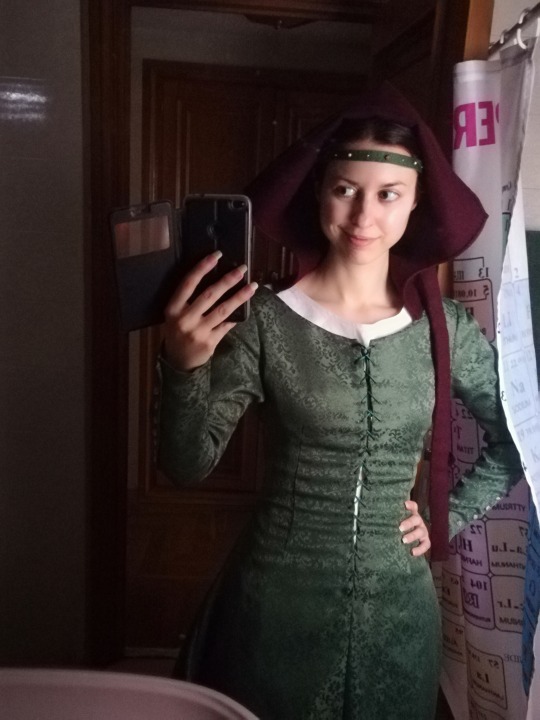

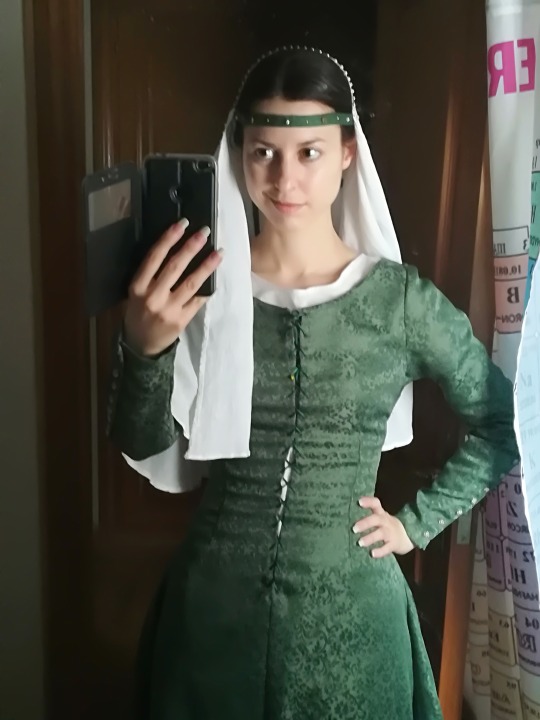
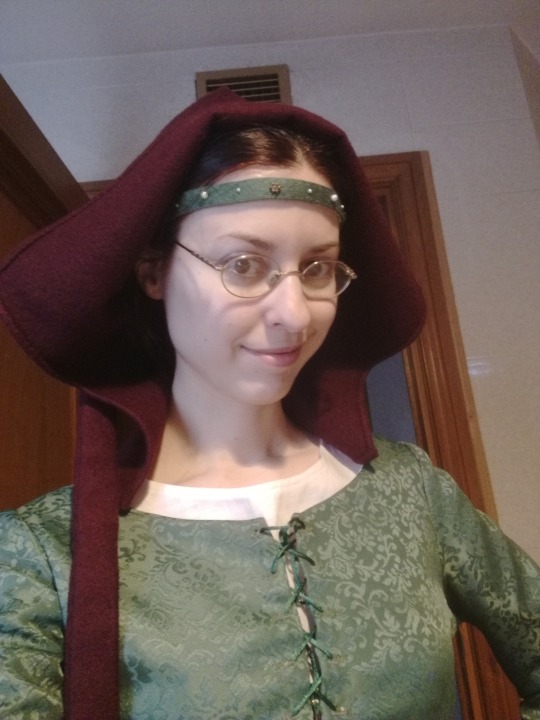
New additions for my late 14th-early 15th Century cotte outfit ⚜️! A pair of burgundy Medieval shoes and striped 'hose' from Armstreet ✨, and some tablet-weaving garters from @/emelunashop on Etsy ✨. I got it all in dark green and burgundy to fit the colour pattern of my damask cotte ensemble 💚💗
Also, some casual test pics (I since had the cotte slightly altered to remove a couple of front seams and give me more lacing allowance, and lowered the chemise's neckline as well to better fit the cotte), featuring the open hood and a couple of styles with the (faux) pearl-beaded linen veil. I have pretty much shied from the wimple styles in my Medieval reenactment so far because well, the baggage for female headwear is deeply steepled in religious patriarchy and gendered modesty mindsets, and that issue has always bugged me 😬. It can look interesting from a purely fashion standpoint, but yeah, it's hard for me to separate the two from a feminist pov. Still, I tried it very casually with a separate linen kerchief to see how it would look (minus the braids) 😅
14th Century reenactment
DeviantArt
FB cosplay page
IG cosplay page
#14th century#medieval reenactment#14th century reenactment#15th century#14th century fashion#15th century fashion#middle ages#medieval#medieval fashion#15th century reenactment#historical#historical fashion#historical reenactment#reenactment#reenactress#My reenactment#medieval hood#open hood#liripipe hood#cotte#cottehardie#historical costuming#medieval costume#medieval costuming#fillet#medieval headwear#medieval hairstyle#medieval women#medieval shoes#poulaines
6 notes
·
View notes
Text
In the 14th century, Arthurian festivities took place in cities along the Rhine Valley, from the Netherlands to northern France. In Britain, nobles organized roundtable reenactments of important Arthurian stories during special occasions in which participants would imitate and take the names of Arthur and his knights.
According to records a lot of people in Medieval times were named after characters in King Authur stories. This practice marked the beginning of a transition from a patrimonial system of naming to a liberal one in which the parents could choose their children’s names based on tastes, culture, religion, or other significance.
During the reign of the Plantagenet dynasty and after, English kings used Arthurian lore to promote their rule in two ways. They legitimized their reign by creating genealogies that began with Arthur and they tried to imitate the values that Arthur represented during the middles ages.
#king arthur#literature#medieval#middle ages#geoffrey of monmouth#legend#english literature#fantasy#britian#festival
3 notes
·
View notes
Text
Dressing the Despencers pt 3: The End of An Era
Part 1 | Part 2
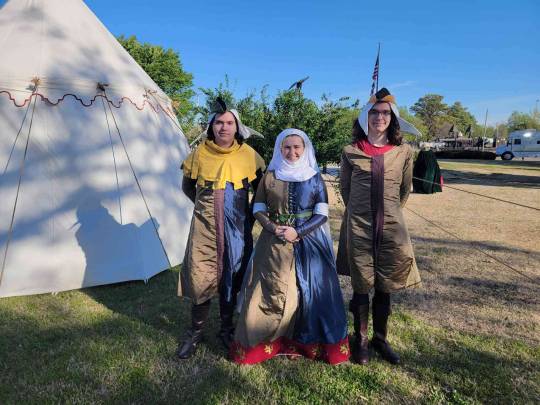
I had to accept that due to time constraints and a sum total of 1 hour to fit two people, my dreams of fully buttoned full length cotehardies would not be fulfilled. However, I am very satisfied with the way things turned out. My cuffs were long enough and sleeves snug enough to prevent riding up, and did not need the planned emergency Glamorgan chevronelly cuff. The mens' cotes were kept long (just below and just above the knee) for personal taste of the wearers. Both boys were put in hoods, though I seem to have failed to catch a picture with Thomas le Despencer in a hood. I have a habit of leaving my phone in the cast tent, so I am not surprised. The yellow dagged hood was my first foray into dagging and I am OBSESSED.
As both of the boys playing Edward and Thomas le Despencer were new to the historical costuming scene, neither were comfortable with the snug fit in the torso of a good cotehardie and requested an expansion to fit more like T-shirts. Due to the short time remaining, I opted to go for a stripe of dark brown linen down the front opening to ensure a semi-unified look. Unfortunately the literal last minute nature of this change resulted in some puckering down the front of each cotehardie that makes my eye twitch. I was terribly sad as this decision came after I'd installed what felt like thousands of buttonholes down the front of Edward's cotehardie.
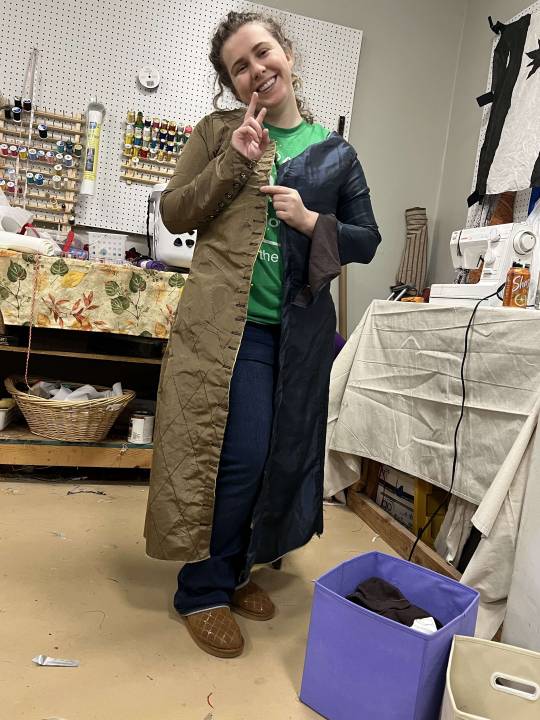
Alas, some concessions must be made for the hellish clash of the impending deadline of an event and the limited available time for fittings with students. I have very mixed feelings about the results of this project, as I feel I did not make these costumes up to my standards, but I am incredibly proud of what I managed with the restrictions and barriers I encountered.
Some highlights:
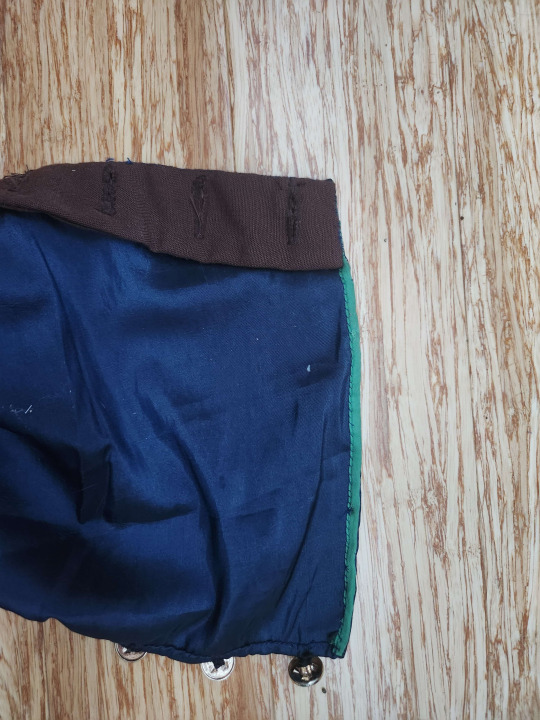
To maximize the length of the sleeve and reduce the bulk, I applied a piece of 3/8" polysatin bridal ribbon to the serged edge with the tiniest back stitches I've ever done, then folded the ribbon to the inside and whip stitched it in place to secure the edge and hide the serging. To prevent the thin satin from tearing where I applied my (machine) buttonholes, I took a scrap of linen, folded it in half, and applied it to the buttonhole edge as a facing to take the majority of the strain of the buttons off the fashion fabric.
At the suggestion of Countess Christyana at LPT, I made a long strip of craft felt to apply to the inside of my hem, backing the lions. I found this gave a body to the bronze and blue fabrics that they did not have previously, giving me a much better silhouette, as well as stiffened the edge of the dress and helpfully preventing me from tripping over my own two feet. I wore it with just the craft felt basted in to one dress rehearsal before applying a facing of scrap muslin to the interior edge. This encased the felt, preventing it from picking up every blade of grass in the state of Oklahoma.
Regrettably I have no pictures of the process of inserting the felt, but my process was simple. First, I applied the felt as a facing, turning it towards the interior edge. This I basted fairly loosely to the seam allowance where the red trim is attached to the bottom of the dress.
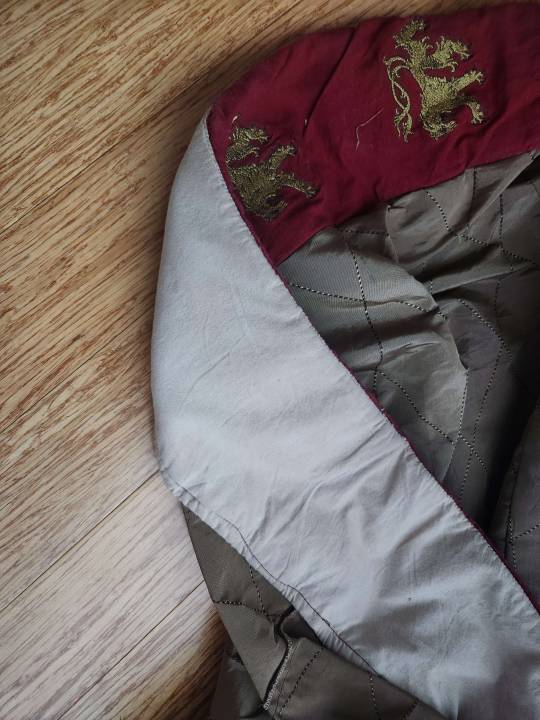
I then cleaned up the edge where the "grass guard" met the felt met the red embroidered band with some small whip stitches to give a crisp, clean finish.
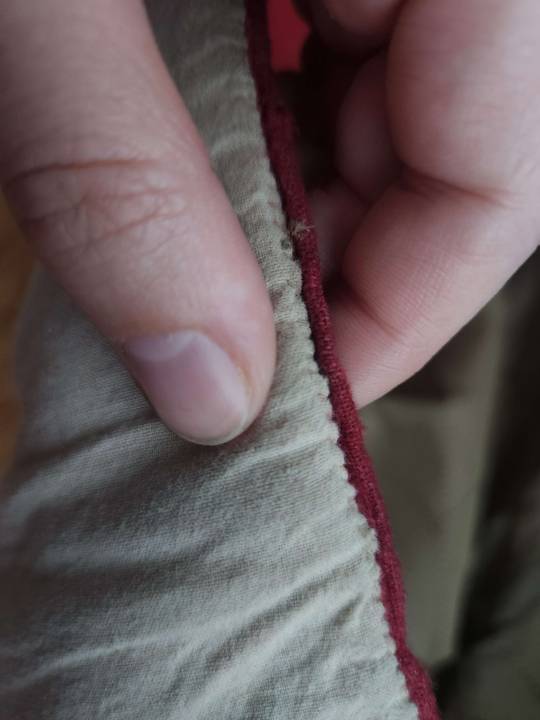
After three days in a variety of weather conditions, the interior lining did relax a little as seen below, and will require some cleanup.
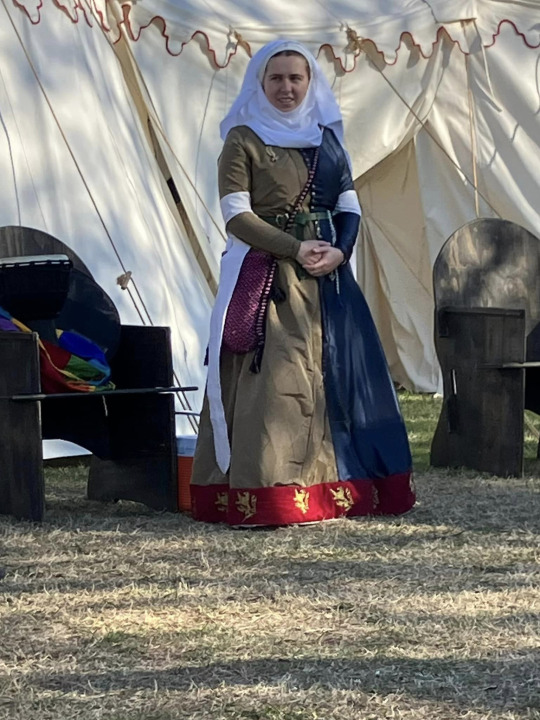
Pictured: Baroness Elizabeth Despencer attending the court of His Majesty Edward III, wondering why, exactly, one of the privateers has been handed the sword of state. (it was for a bit, we promise)
Also seen above, I purchased 14 badges of Prince Edward of Woodstock for the members of Prince Edward's Court (court 2) to wear, as a gift to the wonderful cast members who variously learned and developed new skills, stepped out of their comfort zones, and maybe let me turn them into human barbie dolls a little bit.
I really enjoyed wearing this outfit for three days through the course of the Norman Medieval Fair. I was incredibly worried about the polyester fabrics causing me to overheat, but found the linen lining and tight fitting torso prevented the polyester from building the dreaded heat pocket of humidity, and I stayed fairly cool and dry throughout the weekend. I found a personal preference for the structure and bulk of a wimple and veil when the face edges of both are folded, providing protection from the dust on the wind and the blazing sun. I cheated and safety pinned the bottom edge of my wimple together in the back, though the rest was secured by a single pin through the crossed upper edges to my brigitta cap and held tight by the pair of pins that attached my veil. Dancing in this garb made me feel more regal than I ever have in my life.

Pictured: a happy baroness with croissants. Fed nobility is happy nobility!
Unfortunately due to mental and physical health issues, I will not be returning as costuming director to the cast.
What comes next?
A klappenrock for a commission
Lesbian Minoan ;)
Coordinating Roman and Greek for myself and my consort
an attempt at a little viking cap!
a nap, probably.
#society for creative anachronism#historical costuming#historical reenactment#norman medieval fair#medieval#sca#arts & sciences#a&s#14th century#cotehardie#kirtle#medieval costuming#cote
6 notes
·
View notes
Note
I forgot to send the other history asks 😭 7, 12, 22 (if your comfortable doing it), and 29
7. [Favourite] Historical dressing, uniform, or costume?
i'm guessing it means era of historical costume..? either 1820s or 1910s (in the west)—also mid-16th century italy, but that's just bc it's the only time period pre-1790s that i've researched the fashion of (ok except 14th century french peasants, they weren’t very stylish though)
12. Would you take part in reenactment? In what era and as whom?
YES. any era and as (almost) anyone. preferably late 19th century/early 20th century though!
22. [random historical fact about the place you’re living in right now]
i don't really know anything about where i'm living, and besides i'm not too keen on doxxing myself /lh—
but i do know some things about alpena, which isn't super far away? everything below i’ve remembered either from museums or just looking around
so back in the day alpena was super rich. at first it was a logging & secondarily a fishing place, but by the late 1890s that was fading, but it didn’t become obsolete because then it got into manufacturing (idk what exactly, i know there's a cement plant and there's a [now abandoned] paper mill too. they might have also manufactured automobiles at one point? i don't quite remember) and mining, particularly shale & limestone bc it has big quarries in it and nearby. alpena county had the highest millionaire-to-population ratio in michigan at some point around then. <- that’s fairly basic information sorry but i don't think any of you know much about alpena...
29. Are there any great historical mysteries that you are interested in?
who is dan cooper & what happened to him, and did the anglin brothers & frank morris survive their escape. though i’m not sure if those are great historical mysteries
#thanks for the ask! sorry my response took a while#ask#(i feel like me talking about alpena a lot while insisting that i don't live there makes it seem like i actually do 😭 i don't i promise)#(i just know things about it bc again: the museums)#(also the fact that leon czolgosz lived there for a time)
4 notes
·
View notes